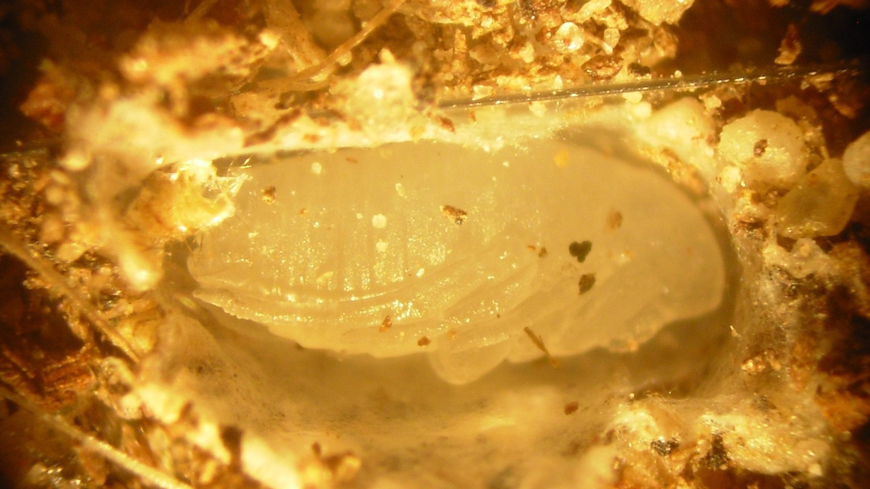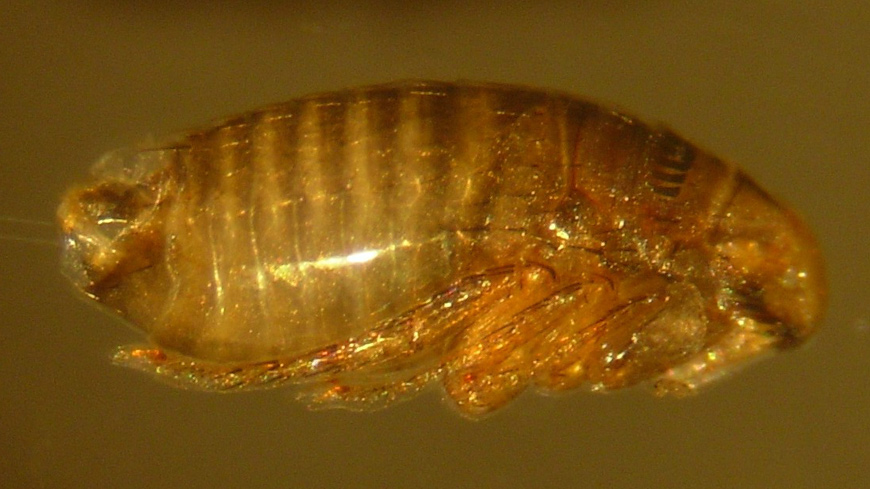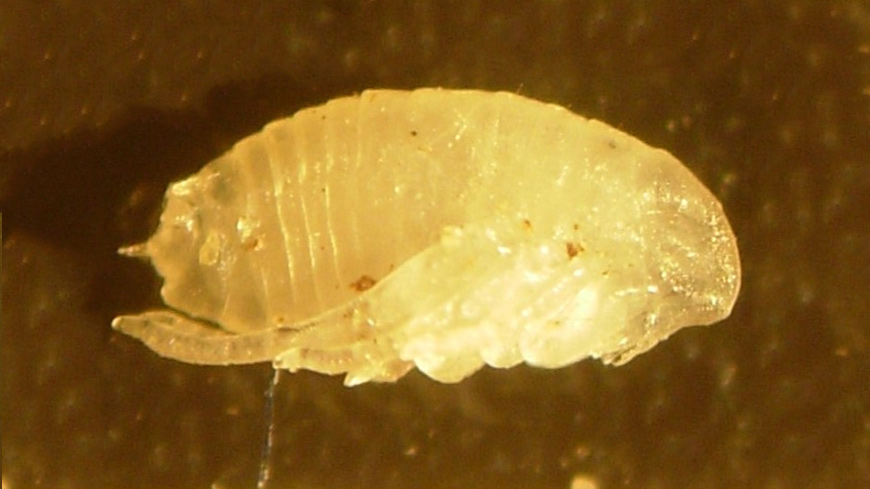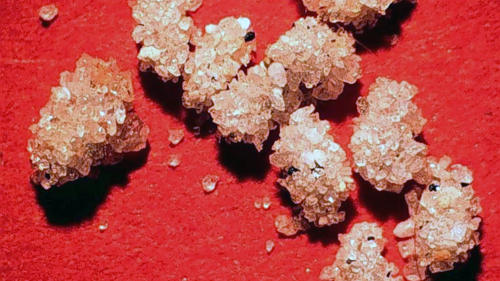
Img 1 A cat flea cocoon torn open to reveal a young, white pupa inside.
Summary
Flea pupae closely resemble adult fleas. They have compressed bodies, no wings, inconspicuous eyes, short antennae, and elongated piercing mouth parts. The legs and appendages are free from the body wall (exarate pupae). The pupae transition from white to yellow to brown. Pupae are about the same size as adult fleas, 1.5 to 3.2 mm.
Flea pupae are rarely visible, because most larvae pupate within cocoons. However, sometimes naked pupae develop without cocoons.
Details
What Flea Pupae Look Like
Color
After larvae molt into pupae, they remain white for 5-9 days Img 1. Then becoming yellowish for 2-3 days. Finally, the pupae darken into a brown color. Combs and bristles turn black 1-2 days into the brown stage Img 2. When they’re ready to emerge, the pupae are nearly as dark as adult fleas. These color changes occur on the underlying adult cuticle. The pupal cuticle remains colorless.
Size
Mature larvae are 4-5 mm long, and 0.5 mm wide. Prior to pupating, they fold themselves in half. A doubled-over, U-shaped larva measures 2.5 x 1 mm. While pupating, the larval head and last three body segments are lost. The body then slightly shortens and widens. Folded larvae have some spare space within their cocoons. But after pupation, there’s a considerable amount of unoccupied space.
Pupae are about the same size as adult fleas, 1.5 to 3.2 millimeters in length. However, the cocoon structure adds to their size. Cocooned pupa are 4-5 mm long, and 2 mm wide.
Body Shape
Tissue Reorganization
As a larva transitions into a pupa, body tissues are broken down and reorganized. The larva withdraws into its cuticle’s center. As a result, the head, prothorax, and last three abdominal segments become semi-transparent. The future pupa resides in the remaining opaque, creamy-white area, from the mesothorax to the sixth abdominal segment. The pupal head develops from the larval prothorax and mesothorax.
Fluid from its last 3 segments gets absorbed 6-12 hours before the larva molts. The segments then collapse. Fluid disappears from the anterior parts soon after, but the rigid head capsule doesn’t collapse. A pupa emerges from the old larval cuticle 3-8 hours after the posterior segments collapse.
Shape
Shortly after shedding the larval cuticle, the pupa’s body gradually shortens and widens. While turning brown, the pupal musculature is transformed to the adult structure. As a result, the brown pupa assumes a dorsally humped posture. Flea pupae have the same general shape as adults. Pupae have a compressed body, no wings, inconspicuous eyes, short antennae, and elongated piercing mouth parts.
Appendages
Flea pupae are exarate pupae, meaning their legs and appendages are free from the body wall (obtect pupa have appendages fused to the body wall). They resemble adults, with legs folded up next to the body. 2-24 hours before molting into adults, the legs break away from their close position on the abdomen.

Img 2 A mature flea pupa in the brown stage. Flea pupae legs are free from the body (exarate pupa).
Pupal Cuticle
The pupal cuticle acts like a sheath, holding the legs and body in position until the adult emerges. Mouthparts are also contained in pupal sheaths. As an adult emerges, the feet are the last body parts to leave the cuticle. The pupal socks soon get rubbed off against the cocoon wall. All the shed larval and pupal casings remain inside the cocoon.
Cocooned vs Naked Pupae
Most flea larvae pupate within camouflaged cocoons Img 4. However, not always. Those without cocoons are termed naked pupae Img 3. Naked pupae develop when there isn’t a nearby physical object, or vertical surface, to orient themselves with and attach silk to. Naked pupae also occur if the substrate is shaken during cocoon formation. Around 50% of disturbed larvae will abandon their cocoons. They’ll even vacate fully formed cocoons, as there’s an 18 hour window before pupation begins.
The cocoon isn’t necessary for survival. Naked pupae still successfully become adults.

Img 3 Cat flea pupa without a cocoon (naked pupa).

Img 4 Cat flea pupae within camouflaged cocoons.




You must log in to post a comment. Log in now.